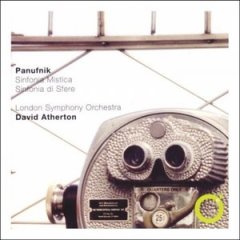Panufnik: Sinfonia Mistica - Sinfonia di Sfere (2006)
Panufnik: Sinfonia Mistica - Sinfonia di Sfere (2006)

Sinfonia Mistica (1977) 1. Molto Andante 2. Molto Allegro (Fig.5) 3. Molto Allegro (Fig.19) 4. Molto Allegro (Fig. 32) Sinfonia di Sfere (1975) 5. Poco Andante 6. Poco Allegro (Fig.9) 7. Poco Andante (Fig.16) 8. Andante (Fig.25) 9. Molto Andante (Fig.50) 10. Molto Allegro (Fig.65) London Symphony Orchestra, David Atherton - director
Panufnik is memorable, at the most trivial of levels, for music that is either extremely quiet or very loud. There is of course a lot more to him than that but it is one of his aural ‘signatures’. These two symphonies of the 1970s continue the pattern. They each owe something to either mathematics or geometry … and that is not, in this case, a cue for music enthusiasts to exeunt omnes.
The Sinfonia Mistica explores the mysteries of the number six and happens to be the composer's Sixth Symphony. It is a work of spare sounds - minimalist but in a non-Reich sense. This is a work of long and measured paragraphs in which mysteries appears to open before the meditative listener. There is a great lyrical theme in the final irresistibly surging section contrasting with the reverential whisper of the opening four minutes. If you know his hallmark works of the 1950s and 1960s (e.g. Sinfonia Elegiaca, Sinfonia Sacra and Heroic Overture) the pace and contours of this hymnal theme will be instantly familiar. Under that arching and potent oratory the orchestra chatters in thrumming mitrailleuse triads related to the same chatter in the second track where basses, horns, bassoons and clarinets batter away in iterative fury.
The Sinfonia di Sfere (No. 5) is helpfully tracked in six sections. We are told that it is shaped by faithful adherence to symmetry but the composer recommended that such analysis should be studied after the work has been heard. The pained insistence of the searing and searching violins leads into a soliloquy for solo trumpet. This is no harangue but music played as if in prayer. The wandering lead thus offered is then taken up by the horn. Chattering woodwind and spatially separated drumming from a variety of instruments give the work forward momentum. This dynamism is short-lived rather like the hell-bent Blitzkrieg of the middle movement of Sinfonia Elegiaca – also typically flanked by two big quiet movements. Orchestral piano plays its role in the Sinfonia di Sfere at various points including during the second Poco andante and the following Andante which at times has a lightly dissonant Bachian feeling. This is again relieved by antiphonal writing for drums. There is a wildness in this writing even if you are also conscious of patterning (3:30 in the andante in tr. 8). Panufnik had an affection for drums (timps, side-drum, tom-tom) and they appear in aggressive spaced-out counter-volleying in the Molto andante which also has massed strings that stab, shriek and surge over and through the cannonade. This assault continues into the Molto allegro finale which ends amid slammed-out, hammered, fast-thrusting protests: part-groan, part-roar.
The concise notes are by Antony Hopkins the composer and music writer. I presume that these two works featured in his BBC 'Talking About Music series'. It is a pity that they do not give details about the premieres.
You can read more about these two symphonies in Paul Conway’s superb survey of the Panufnik symphonies. The CD booklet contains notes in English, French and German. Each symphony is laid out on the disc in separately tracked sections: four for Mistica and six for di Sfere.
This is a most valuable addition to the catalogue. Congratulations to Raymond McGill of Explore for striking the deal with Decca to bring this exemplary analogue recording back into the catalogue. We can now appreciate Panufnik's two late symphonies (five and six of a total complement of ten if we also count the lost Symphony of Peace and the first two symphonies) as works articulate through both spiritual concentration and extreme violence. ---Rob Barnett, musicweb-international.com
download: uploaded yandex 4shared mediafire solidfiles mega filecloudio nornar ziddu
Last Updated (Saturday, 08 March 2014 20:44)








